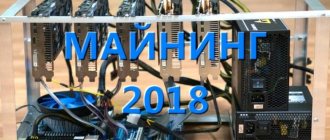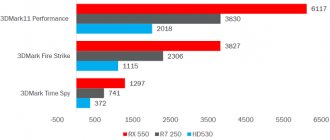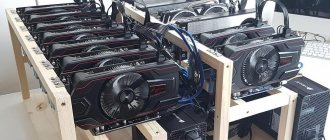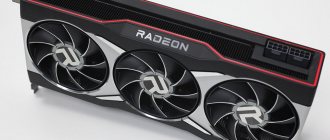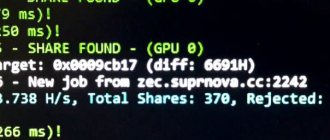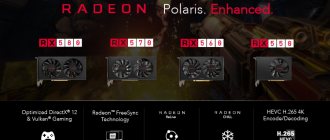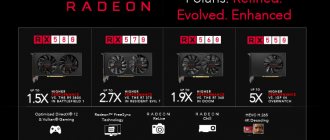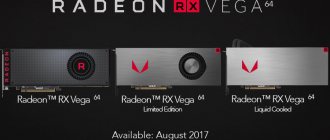The RX 480 series of video cards, well known among miners, has been discontinued. It was famous for its payback speed, as well as characteristics that could easily compete with older versions of the GPU.
It turned out to be a real bestseller on the video card market. Some are still trying to find several copies of this series, but most cryptocurrency miners have turned their attention to the new series - RX 580.
This is an improved version of its predecessor, which has similar characteristics, but is even more adapted for mining.
RX 580 Specification
The first thing that catches your eye is the increased core frequency. This will allow you to get better performance in some algorithms. The chip frequency is 1340 MHz (base – 1257 MHz), and for the memory this figure starts from 1750 MHz.
All this runs on the overclocking-friendly Polaris architecture. Therefore, we can get an additional 20% performance by increasing frequencies and updating drivers.
| Name | Meaning |
| Energy consumption | 185 Watt |
| Memory size | 256 Bit |
| Number of computational units | 2304 |
| Video memory | 4.8Gb |
| Memory type | GDDR5 |
| Productivity | Up to 6.2 teraflops |
| Bandwidth | 256 Gb/s |
| Cooling type | Air |
Mining on an RX 580 with 4gb of memory will have approximately the same performance as mining on an RX 580 with 8gb. The cost of a video card starts at $300. In most stores the price is greatly inflated, even reaching $500. In rubles, the average cost will be about 28,000. GPUs with 4gb and 8gb of memory have been released. But here you can avoid overpaying and get by with the first option. This way you will save an extra 20-30$.
This is due to the fact that the advantageous algorithms for this GPU use not the amount of video memory, but the frequency.
When choosing a video card, the user will see many models of this series. These include Sapphire Nitro+, Armor, Aorus, Asus and others. But their characteristics differ little from each other. The only differences are the cooling systems, which will not play a decisive role in mining.
But if you make a farm (rig) from several video cards, then it is worth analyzing all models, since they have different energy consumption. And the smaller it is, the better it will affect the farm.
Choosing the best OS
Choosing the right operating system can significantly simplify working with a farm and even reduce costs. When it comes to Windows vs. Linux, RX 580 farms usually choose the latter OS. Hive OS has a number of important advantages over Windows, the most significant of which are:
- There is no limit on 8 video cards.
- No need to go through the complicated process of choosing the right drivers.
- The OS was originally developed and adapted for mining.
- Ability to work without monitors (using emulators).
- There is no need to have an SSD or HDD, a regular flash drive of 8-16 GB is enough.
- WatchDog is built into the system, there is no need to pay extra for it (as is the case with Windows).
- Easy setup and functional remote monitoring.
- No need to buy an expensive license.
- Notifications in Telegram in real time.
You should also take into account that if pirated copies of Windows are installed, the farm may be confiscated, as this is provided for by law. With Linux there will be no such problems, which is another important advantage. One of the few advantages of Windows, namely the ability to use a video card for tasks other than mining, is irrelevant, because 99% of farms are initially created specifically for the extraction of cryptocurrencies. This is the main task.
Mining Ethereum on RX 580
For this video card, Ether is the most profitable algorithm. It will be about 20 MH/s. By overclocking the device, the user increases the hashrate to 30 Mh/s. Based on these indicators, let's calculate the predicted profitability.
| Name | Meaning |
| Currency | ETH |
| ETH income per day | 0,003117 |
| Income per month | 0,093518 |
| Hashrate | 25 Mh/s |
| Income USD per day | $1,26 |
| Income per month | $37,7 |
| Energy consumption | 180 Watt |
| Net profit per day | 0.91$ |
| Net profit per month | 27.3$ |
Let's see what speed the NiceHash calculator predicts for us.
If we take the average cost of a GPU at $410, then we will pay for the device only in 451 days. Although the processing power is the same as the RX480, the payback period is longer. This is due to higher power consumption.
Using the DaggerHashimoto algorithm we get 26 MH/s, which is a good result for an unoverclocked device. At the same time, we can launch dual mining by connecting Decred to Ethereum, which will bring additional profit without interfering with another algorithm.
In some cases, we can see that the hashrate does not even exceed 23 MH/s. At the same time, the video card was already overclocked to its maximum. This is due to the fact that instead of the usual Samsung memory, the manufacturer decided to use Hynix memory, where the timing diagrams are relaxed. This was done in order to maintain a higher operating frequency. The problem occurs when mining on the radeon RX 580 Nitro. Apparently it is more suitable for gamers than for cryptocurrency miners.
In this case, only replacing the BIOS with modification of the timings will help. You also need to update your drivers.
But mining on the RX 580 Armor video card shows more encouraging results. Even without overclocking we get a speed of 27 Mh/s. But this device is not chosen so often, because due to the limited performance of the drivers, it is impossible to optimally configure energy efficiency.
Additional Tips and Features
In addition to standard technical characteristics, Radeon RX 580 video cards are endowed with unique properties that set them apart from available analogues from competitors.
- Availability of a powerful heat removal system. It consists not only of three copper-composite tubes, but also of a cooler equipped with 9-centimeter blades. The developers claim that the fan is 23% more efficient than similar offerings. Thanks to this, the RX 580 Samsung firmware for mining runs without problems.
- The ability to quickly determine how efficient the card will be in certain conditions. The LED indicator located at the bottom of the device helps to calculate the required indicators.
- Minimum noise level. The video card is easy to use for mining virtual currencies even at home. There will be no problems even if you connect several devices at once. How much or little each of them mines depends on specific conditions.
- A special interface that makes it easy to customize the device to personal preferences. You can adjust the supply voltage, cooler performance along with power and clock frequency.
- Availability of a special overclocking program, activated with one click. The settings are set by the user independently, on any video cards for mining.
To read: How to mine DASH
In addition, there is a graphics card option, which is designated as DUAL. This is a more efficient version of the card based on the well-known chipset. And it also has its own characteristics.
- A processor that produces an increased frequency of 1.38 GHz. Productivity also remains at a high level.
- Sophisticated heat dissipation system. Optimized fans have reliable protection against dust penetration inside.
- Availability of an overclocking utility that allows you to increase performance.
- Optimal balance between price and performance.
- At minimum and medium loads the noise level is very low. The fans operate in passive mode until the temperature exceeds 55 degrees. Even if any indicator of the video card is overclocked.
What else to consider when mining cryptocurrencies?
Purchasing video cards and calculating payback are steps that will not be enough to obtain stable results. It is worth taking into account the total cost of the farm, and this does not only apply to electricity consumption. Farms are often assembled with a base of six video cards, this allows you to save on costs in the future. The cost will depend on how much power the user needs. This also determines whether it will be more profitable to mine Ethereum and what indicators the payback will reach.
The more power, the more expensive components the owner requires. Because of this, the payback period changes, usually upward.
To increase the hashrate, it is recommended to set the appropriate frequency for the video memory. Flashing faster timings also gives good results, as noted by a large number of users. The main thing is to remember that working with the BIOS always remains a risky endeavor, the result of which may be the inability of the card to work. It is recommended to install firewood or drivers before mining.
In addition, you can lower the core frequency and then flash the BIOS - similar steps also give good results.
Different modifications lead to different effects. The firmware process will be safer if you follow the following recommendations:
- Saving the original file so that functionality can be quickly restored.
- Using original firmware. It is worth abandoning ready-made firmware for other video cards.
- Modified timing values should be selected specifically for a particular type of memory. Then the video card will load correctly, even if you initially make mistakes when specifying certain numbers.
You can purchase video cards in online stores or by contacting regular sellers. Sometimes shipping costs make remote purchases not as profitable as we would like. It won't be difficult to find official drivers for AMD RX 580 mining.
Dual mining Ethereum and Decred
When connecting Dual mining, Decred is almost always mined along with Ether. The currencies use different GPU resources, which means that they will not reduce each other's profits. Having flashed the BIOS under ETH and DCR, we get a result of 30 Mh/s speed on Ethereum, and 1000 MH/s on Decred. This is a good result.
The core frequency on the device under test is 1150MHz, and the video memory is 8g. The latest version of the ClayMore miner has been installed.
If you use the default settings, mining on the Radeon RX 580 8gb produces only 24.5 Mh/s. The DCR rate continues to remain at 950-1000.
Alone, without ether, it produces the same 1000-1200 MH/s hashrate.
The NiceHash profitability calculator shows even more speed that can be achieved.
With indicators of 30 mh/s for ether, and 1.4 GH/s for Decred, a profit of 15 USD per month is predicted. This is at a Bitcoin exchange rate of $6,745 and taking into account electricity costs (0.1 USD/kWh per hour), which “eats” a large part of the income.
Currency rates and statistics can be viewed on the official blockchain website.
Some cards with similar characteristics produce different results in dual mining. For example, the Armor card from MSI will be somewhat inferior in profitability to mining on the Radeon RX 580 Nitro.
How to overclock a video card for mining: results
The top card of the 500 line shows good results. However, the high cost of the device itself makes one think about its economic feasibility. Considering how much even a top-end nitro 580 video card brings in mining, it will not be possible to recoup the investment even in a year. Fluctuations in coin rates and card values make it difficult to predict for such a long period.
Therefore, the question of whether it is worth investing in expensive cards or whether you can find something cheaper, each of the miners must decide for himself in accordance with his preferences and the situation on the card market in his city. If it is possible to purchase the RX 580 at a reasonable price, buy it; if not, look for another option.
Mining on other algorithms
For this video card, other algorithms are rarely used, but they can also bring benefits in due time. The popular Zcash algorithm (zek) will produce a speed of 300-320 Sol/s. The CryptoNight algorithm (Monero XMR) will show a result of 600 H/s. LBC gives 0.165 GHS.
Pascal (PASC) will mine at a rate of 0.86 GH/s, and X11Ghost (SIB) will produce 8.5 MH/s.
There is no need to manually monitor the cost and complexity of the currency. If the latest version of the miner is used, the program will automatically start working with the algorithm that has become profitable. To do this, you just need to make a benchmark.
It will show the user at what speed a certain currency from the list will be mined.
Productivity of mining different cryptocurrencies
The PowerColor RX 580 video card is used to hash blocks using three algorithms:
- Ethash. The algorithm is used in the program code of Ethereum, Ethereum Classic, Krypton, Soilcoin, Goldiam, DubaiCoin coins. The hashrate after overclocking reaches 31 megahash per second, the operating temperature reaches 56 degrees, and power consumption is 200 watts per hour.
- Cryptonight. The algorithm underlies the Monero and Electroneum coins; the hashrate reaches 850 hashes per second at an operating temperature of no more than 53 degrees. Electricity consumption is 160 watts.
- NeoScrypt. CrowdCoin, Dinero, GoByte, Innova, Vivo and Phoenixcoin coins are mined at a speed of 930 hash per second, the board heats up to 57 degrees. The power consumption is 240 watts.
The memory module installed on the PowerColor RX 580 is manufactured by Hynix, so it is recommended to use low memory intensive algorithms. Miners working with the Ethereum cryptocurrency are advised to lower the GPU frequency to reduce the power consumption of the board.
Overclocking and firmware RX 580
Overclocking of this device follows the same principles as other GPUs. To do this, we need the MSI autoburner program (AfterBurner).
The frequency changes differently for a specific currency. For example, if we mine ether, then we only need to overclock the RAM, since the power here is determined only by the speed of the memory. This means that the core frequency can be lowered. This way the card will become cooler and power consumption will drop. A temperature that will constantly remain around 65-68 degrees will allow the device to last much longer.
If we mine Zcash, then everything turns out the other way around - we need to increase the core frequency, but the memory can be left at the basic level.
Both increasing and decreasing the frequency must be done carefully. In both cases, brute force can cause incorrect balls and errors in the GPU. If the user does not know what to do, then it is better to simply follow the instructions.
The video below talks about how to make optimal firmware and overclock the RX580 so that mining on 8gb and 4gd brings at least 30 MH/s speed.
Well, don’t forget to just update the drivers. AMD has released special drivers optimized for mining. The latest version can be downloaded from the official website by going to the Drivers&Support section.
Setting up video card overclocking
After the timings have been changed, it's time to overclock the card. First of all, you should decide what parameters you need to overclock to mine the selected currency? Here are some examples:
- Ethereum mining is entirely dependent on memory speed. Therefore, in MSI Afterburner, setting up the RX 580 for Ether mining is done as follows: move only the slider responsible for the RAM frequency to the right. There is no need to increase the GPU frequency and power characteristics; you can even lower them to reduce electricity consumption.
- Zcash mining is primarily related to core frequency. Therefore, we increase this value until the card operates stably. There is no need to change the RAM frequency, and the voltage can be lowered (however, make sure that the hashrate does not drop).
The extraction of other coins is associated with its own subtleties; they can be found in thematic articles or on forums.
You can check the effectiveness of each set of settings by observing how the miner works. If there are no incorrect balls during operation and the system does not generate error messages, you can change the parameters a little more. If it is noticeable that the hashrate has gone down, you should return the parameters back. So, using trial and error, you will be able to find the optimal settings.
Comparison with RX 480
Now we will compare the Radeon RX 580 with its predecessor, and determine whether the new generation could become a worthy replacement for the previous one. Let us note those characteristics that differ between both devices.
| Model | RX580 | RX470 |
| GPU Base Frequency | 1.257 MHz | 1.120 MHz |
| Overclocked GPU frequency | 1.340 MHz | 1.266 MHz |
| Polaris version | 20 | 10 |
| Pixel fill rate | 42.88 GPixel/s | 40,512 GPixel/s |
| Texture fill rate | 192.96 GTexel/s | 182,304 GTexel/s |
| Computational performance | 6,125 TFLOPS | 5,833 TFLOPS |
| Power consumption | 185 Watt | 150 Watt |
| average cost | 25500 rub. | From 19,600 rub. |
All other technical specifications are the same.
From this comparison, we see that these cards are very similar in terms of power, but the RX 580 clearly loses in cost and power consumption. Because of these indicators, the payback period increases. And this increases the risk of investment. If you build a farm, you will have to seriously take care of reducing energy consumption.
The RX 470 wins in this regard, since you can start mining right away, without even changing the firmware and setting up drivers.
The hashrate that we can squeeze out of the algorithms is also not much different for both video cards. The RX 580 (not all models) is only slightly ahead in this regard. But in both cases, on air we can get a maximum of a little more than 30 MH/s.
We can conclude that the RX 580 and 570 are analogues of the RX 480 and 470 series. And not the cheapest. But buyers don’t have to choose, since the early series can no longer be found on the market. And what’s left is so overpriced that it’s still more profitable to purchase a new series.
conclusions
This is how things are, dear friends. It’s useless to argue with the numbers, and it turns out that the RX 580 is far from the best video card for mining. However, this does not mean that the card from AMD is bad in itself; its results are quite decent and generally fit into the original framework of our understanding of it. The fact is that the cost of these cards has long been greatly inflated compared to the recommended prices, and this imbalance has long been significantly greater than that of cards from the competitor’s camp.
In general, mining on the RX 580 video card is still a very profitable activity and will remain so for quite some time. Is it worth buying these cards and building a farm on them? Definitely yes. If you want to mine Ethereum and its forks, then these cards are perhaps the best tool for this today. Is it worth buying these cards at today's prices? But here we would say, most likely not. However, this is a matter of individual perception and it all depends on how satisfied you are with the current payback period for video cards. If you're willing to wait, it's likely worth the wait. If you think that it is better to overpay, but enter mining now, then this is also a completely understandable desire.
Be that as it may, dear friends, we are grateful for your attention. We hope that this article was useful to you, we wish you to always find video cards at good prices and successful coin mining.
Profitability
Based on the hashrate of popular algorithms, we have already found out that rx 580 mining will definitely be profitable. The exchange rate is constantly changing, but the average monthly income remains about $30.
The payback period will be at least 15 months, and this is a serious drawback, because during this time the situation on the cryptocurrency market can change significantly. But this period becomes shorter if you build a farm of several video cards, while reducing power consumption to at least 105 Watts. In Dual mining mode this is possible.
Other algorithms are not yet profitable to use. For example, Zcash will bring in less than $20 per month, which is completely unprofitable.
How to flash a video card and driver for mining
The algorithm by which the RX 580 firmware is run for mining is not too complicated. But you need to do everything in order, without skipping steps. It is also important to remember that all actions must be performed as an administrator. Here's the procedure:
- Launch ATI Flash, save the BIOS file. If necessary, we make a backup copy.
- Open the resulting file using Polaris BIOS Editor. On the right side, change the Timing Strap parameters. The selection should start with 1500, increasing or decreasing them depending on the behavior of the system.
- We save the changes and flash the converted file into the card using ATI Flash.
Don't be upset if you don't succeed on the first try. Selecting timings is a tedious and time-consuming task, which may require 2-3, or maybe 5-10 tests. But the resulting increase in productivity will more than pay for all the effort and time spent.
Energy consumption
To reduce energy consumption, it is important to set the device to downvoltage. This is an overclocking technique that reduces the voltage per core to reduce overall power consumption.
Downvolting is combined with Dual mining and will not interfere with work in any way. Below is a video on setting timings and downvolts for Sapphire 580 and 570.
If a farm of 6 GPUs is used, then the power consumption in any case will be about 0.9 - 1 kW. Each model will have different electricity costs, but the differences are not significant. And there is no way to fix this problem; you will have to sacrifice either power or energy consumption. This is the main flaw of this series.
Review of the Yeston Radeon RX580 4G D5 GAEA video card in mining: get the most out of it
In this review, I propose to get acquainted with the Radeon RX580 4G D5 GAEA video card from the Chinese computer components manufacturer Yeston. I will not provide performance tests in system-wide or gaming tasks, but will talk about a way to optimize this model in mining Ethereum cryptocurrency. And yes, the video card was purchased at a discount in exchange for writing this review, so item 18 is available. If this doesn’t scare you, and also if you want to know how video cards from AMD are flashed, please see cat. If you are at least a little familiar with the topic of such a super-popular trend of using video cards now as cryptocurrency mining, then you probably know that for Ethereum (ETH, Ether) mining, models on chips from AMD RX 4xx and RX 5xx lines are now in greatest demand. The popularity of these particular chips is associated with a good technical predisposition to the DaggerHashimoto algorithm (on which the Ethereum cryptocurrency is based) and, perhaps most importantly, the fact that in mining the performance of video cards, for example, on an AMD RX580 chip with 4GB of RAM, with some modification, can reach approximately similar performance on a significantly more expensive video card based on the Nvidia GTX1070 chip with 6 GB of RAM. Next, I will talk about the details in a little more detail, but now I propose to take a look at the characteristics of the Yeston Radeon RX580 4G D5 GAEA video card reviewed here:
- Video card type: office/gaming
- GPU: AMD Radeon RX580
- Interface: PCI-E 16x 3.0
- GPU: Polaris 20 XTX
- Process technology: 14 nm
- Maximum resolution: 7680×4320
- GPU frequency: 1340 MHz
- Video memory capacity: 4096 MB
- Video memory type: GDDR5
- Video memory frequency: 7000 MHz
- Video memory bus width: 256 bits
- Connectors: 1xDVI, 1xHDMI, 3xDisplayPort
- HDMI Version: 2.0b
- DisplayPort Version: 1.4
- Number of universal processors: 2304
- Shader version: 5.0
- Number of texture units: 144
- Number of rasterization units: 32
- Maximum anisotropic filtering degree: 16x
- Standards supported: DirectX 12, OpenGL 4.5
- TDP: 145 W
- Number of fans: 2
- Number of occupied slots: 2
- Dimensions (WxHxD): 24 x 11 x 4 cm
The packaging is a cardboard box with printing in red and black colors.
Inside, in addition to the video card itself, there is an additional power adapter from 8pin to 2 Molex, as well as small installation instructions. There is no disk with drivers; they can be downloaded from the official AMD website.
The video card itself turned out to be very compact, but at the same time quite heavy. The reason for this is the casing that covers the cooling radiator and at the same time serves as a mounting location for two 90 mm fans. The fact is that it is made of metal, and at the same time quite thick.
Like the vast majority of similar modern models, the thickness of this video card occupies two slots in the system unit.
On top there is an 8-pin connector for additional power.
The external interfaces of the video card are represented by 1xDVI-D, 1xHDMI 2.0b and 3xDisplayPort 1.4.
On the reverse side, the printed circuit board is protected by a metal plate, which at the same time serves as an additional dissipating surface for heat removal; the corresponding inscription “Caution HOT” warns about this.
Let's see what's hidden under the cooling system. To do this, unscrew the four screws and separate the halves of the video card.
The GPU is coded 215-0910038 corresponding to the Radeon RX580 (Polaris). Around the processor are four gigabytes of GDDR5 RAM on eight Elpida W4032BABG-70-F chips.
To cool the voltage stabilizers, a separate radiator is used that is not connected to the main system.
The main component of the cooling system is a combined radiator consisting of two parts.
Heat is removed to the radiator from the hottest components, which are the graphics processor and memory chips, using four air tubes. In general, the entire system gives the impression of being reliable, but we’ll see how effective it is below.
We install the video card into the computer, download and install the latest version of drivers from the official AMD website, and then see what the special utility TechPowerUp GPU-Z tells us about.
The operating frequency of the graphics processor is 1340 MHz, the video memory bus width is 256 bits, the memory type is GDDR5, the actual (reference) frequency is 1750 MHz, the effective frequency is 7000 MHz.
Without load, the processor and video memory frequencies drop to 300 MHz, while the video card temperature remains at 33°C at 30% cooling fan speed.
In stress test mode, frequencies increase to maximum values, temperatures jump to about 60° at 58% fan speed.
Now I propose to finally return to the topic of mining and see what this video card is capable of in its factory state. To do this, we will use one of the most popular Claymore miners in the solo mode of mining only Ether, as well as in the dual mode of parallel mining of Ether and the Decred cryptocurrency.
The results obtained at 17 Mh/s in solo mode and 17.5 Mh/s + 527.7 Mh/s in dual mode are certainly disappointing, so we move on and use the MSI Afterburner utility to increase the video memory frequency, finding the maximum value at which the card works stably . This value became the frequency of 2060 MHz (8240 MHz).
The next step is to install a special version of the “Radeon Software Crimson ReLive Edition Beta for Blockchain Compute” drivers, developed by AMD in August 2022 and designed to optimize the operation of video cards specifically for mining. When installing this version of the driver, you need to remember several warnings from the developers themselves: - the driver is a beta version and is distributed on an “as is” basis, that is, you should not count on updates or bug fixes in the future; — the driver is not intended for graphics or gaming loads.
After downloading and immediately before installing them, it is best to completely remove already installed drivers to avoid possible errors. The easiest and fastest way to do this is in automatic mode using the free utility “Display Driver Uninstaller”.
We install a special version of the drivers and check how this affects the performance of the video card.
Timings are parameters that are stored in the BIOS of a video card and set the duration and delay time during the passage of RAM control signals. By selecting optimal values for them, you can achieve a significant increase in mining productivity. You can select timings yourself by experimenting, but it is best to search on special forums. Not all values apply to all video cards, so you need to look based on the manufacturer of the memory chips (in this case Elpida), its volume (4 GB), and the GPU of your video card (Radeon RX580).
You can find a lot of detailed information about this, so I’ll just say that the optimal value I found was this: 777000000000000022AA1C00EF615C41B0551016BA0D96060060060004061420EA8940AA030004C01914292E692E3B16
The firmware itself is not essentially something overly complex and, if several rules are followed, will not lead to “bricking” the video card. This does not require any special equipment, only a few utilities that can be found in the free distribution: - TechPowerUp GPU-Z - AMD/ATI ATIFlash - Polaris Bios Editor - AMD/ATI Pixel Clock Patcher TechPowerUp GPU-Z is necessary in order to correctly determine the video memory manufacturer to select potentially tested timing values, which we have already done above.
Perhaps one of the main safety rules is the principle of not using firmware from a “very similar video card model,” but modifying your own, factory firmware.
The AMD/ATI ATIFlash utility allows us to first save the factory firmware, and then, after modification, upload it back to the BIOS. To do this, run this program, click SAVE and save the file with the firmware to some secluded place under the name “YestonRX580original.rom”.
I strongly advise against resaving this file in the future, since it is the file that will be needed to return the card to its original state if necessary. Next, launch the Polaris Bios Editor utility, with which you can make changes to the downloaded firmware. To do this, you need to copy the timing value that needs to be flashed into memory and replace it with the values in the cells starting from “1750” and above in section 1 as in the screenshot below. By flashing values starting from this particular frequency, you will thereby protect yourself from the video card freezing immediately after loading it if the timings are not right. In this case, they are used only under load, and thus there will always be an opportunity to correct the error.
Next, click the SAVE button and save the firmware under a new name, for example “YestonRX580mod.rom”. Next, launch AMD/ATI ATIFlash again, using the Load Image button (1) show the modified firmware (YestonRX580mod.rom) to the program and, making sure that the loaded values appear in the program window, press the Program button (1).
When the firmware is completed, a corresponding message will appear, after which you need to restart the computer to accept the changes, but before that it is better to immediately run the AMD/ATI Pixel Clock Patcher utility, which will patch the video card drivers to avoid problems with compatibility with the firmware BIOS.
So, the card is flashed, the overclocking settings remain at the same values, let's check how much the performance has changed.
Well, this is a completely different matter - the hashrate has increased to 30.3 Mh/s in solo mode and 27.2 Mh/s + 816 Mh/s in dual mode.
The temperature of the video card during operation is kept within 65°C at 90% speed of the cooling fans (yes, this is AMD after all). Energy consumption is about 144 W.
If you set a goal to slightly reduce energy consumption, you can experiment with the parameters. For example, by reducing the maximum power consumption value, we get what we intended, but immediately lose a little performance.
Another interesting nuance regarding the Yeston Radeon RX580 4G D5 GAEA is that this model is the basis of some factory-made mining “farms”, for example, an assembly called T-bao FM01 includes eight such video cards, i.e. the total hashrate when mining Ethereum cryptocurrency in this version will be about 244 Mh/s.
In general, the Yeston Radeon RX580 4G D5 GAEA performed very well in mining, the overclocking potential is present, and through the actions described above, the video card quickly catches up in performance with noticeably more expensive models on Nvidia GTX1070 chips, the hashrate of which after overclocking is approximately 31-32 Mh/s.
The main, long-known disadvantage of almost the entire family of video cards from AMD is the increased heat dissipation and power consumption relative to Nvidia, but I consider the advantage of this particular model to be the presence of one rather than two connectors for additional power, i.e. for it you need to use only two Molexes from the computer’s power supply, and, as a rule, there are always not enough of them.
Discount information
The Yeston Radeon RX580 4G D5 GAEA graphics card reviewed above is currently on sale for $599 with coupon code “YTRX580DF.”
The product was provided for writing a review by the store. The review was published in accordance with clause 18 of the Site Rules.
Which drivers to use for coin mining
To mine cryptocurrency, it is best to use the official Blockchain drivers dated August 23.
Or you can download the latest version of your video card drivers, but you will need to enable “compute mode” in them to get speeds of 30 or more Mh/s.
After installing the driver and firmware of the video cards, they will need to be patched using atikmdag patcher 1.4.6.
Temperatures and internal structure
The MSI RX 580 is quite easy to open. First, you need to remove a couple of screws from the back to release the card's thermal backplate, then remove four screws to get to the chip. Turning the card over, we see that three wires are responsible for connecting fans and LEDs, and two more screws are installed on the rear panel.
At the same time, the warranty seal is opened and we see Samsung memory modules (K4G80325FB-HC). OnSemi M3816N power mosfets are used as part of a 6-phase VRM. (power phase)
Which AMD Rx 400, 500 video card is better to buy for mining? Quick response
In 2022, there is no point in purchasing the AMD Rx 400 line, since these cards have been in mining for more than 5 years!
And many of these cards may be physically on their last legs, but they are asking a lot of money for 470/480 on the used market! As for the AMD Rx 500 series, everything is not clear. These are also quite old cards - there are models at almost the same price, but with a guarantee and with a slightly higher hashrate. It makes sense to buy the AMD Rx 500 series only on very favorable terms!
However, if you decide to still purchase the AMD RX 500 series in 2022, then of all our calculations (conducted later in the article) the AMD RX 580 (8 GB) .
Internal cooling system
The card is equipped with 3 square-shaped copper heat pipes up to 8 millimeters thick, which pass through a medium-thick nickel-plated copper heatsink.
There is an additional heatsink in the VRM area (the area where the power phases are located).
The radiator concentrates a fairly large amount of heat on its surface, so two large coolers are installed above the radiator, dissipating heat from the entire surface of the card.
What coins can you mine?
The Ethash algorithm is most suitable for mining cryptocurrency on an RX series video card.
Mined coins on RX 580
| Algorithms | Coins |
| Ethash | Ethereum, EthereumClassic Ellaism, Metaverse, Expanse, Krypton, Ubiq, Soilcoin, Shift, Pirl, Musicoin |
| Equihash | Zclassi, Zcash, Zencash, BitcoinGold, Komodo, Hush, BitcoinZ |
| LBRY | LBRY |
| NeoScrypt | Crowdcoin, Feathercoin, GoByte, Halcyon, Innova, Orbitcoin, Vivo, Phoenixcoin |
Introduction
AMD Rx series video cards are one of the most popular video cards for mining. Miners use AMD Rx470, Rx480, Rx570, Rx580 and Rx590. All of these cards are great for mining. But which one is better to buy in 2022?
In this article we will look at which Rx series video card is best to buy for mining in 2022.
To begin with, let us clarify that AMD Rx series are mainly purchased for mining the Ethash algorithm (Ether) and the difference in hashes for this algorithm is almost unnoticeable among all the above cards. It may differ by only 0.5-1 Mh/s. However, the difference in price, electricity consumption and novelty (for future resale) is very significant.
Thermal pictures
Temperature measurement
| Measuring point | Degrees Celsius) |
| M1* | 64.2 |
| M2 | 49.6 |
| M3 | 38.5 |
| M4 | 43.2 |
| M5 | 38.8 |
| M6 | 35.7 |
| M7 | 26.3 |
| M8 | 37.9 |
*M1 – GPU temperature Temperatures of various parts of the video card, side view
| Measuring point | Degrees Celsius) |
| M1* | 47.8 |
| M2 | 48.3 |
| M3 | 47.5 |
| M4 | 38.2 |
| M5 | 40.6 |
| M6 | 36.7 |
| M7 | 32.2 |
Temperatures of various parts of the video card, top view
| Measuring point | Degrees Celsius) |
| M1* | 50.7 |
| M2 | 49.5 |
| M3 | 45.1 |
| M4 | 38.6 |
| M5 | 25.4 |
| M6 | 27 |
| M7 | 32.2 |
